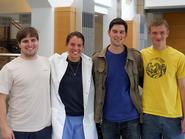
Associate Professor of Biology Michael McCormick directed a group of four students on an adventure to Antarctica in 2012. They were part of a LARISSA expedition led by Principal Investigator Eugene Domack, the J. W. Johnson Family Professor of Environmental Studies. Andrew Seraichick ’13 was one of the students who explored and sampled the ocean waters that are now accessible after the Larson A ice shelves disintegrated.
These sediment samples will contribute to a greater understanding of the microbiological changes in response to a new environment. Now that Seraichick completed his senior thesis on the topic with Elizabeth Huebner ’13, the recent graduates are prepared to pass their work on to Robert Clayton ’15 and Daniel Lichtenauer ’14.
This new team of students will continue working to discover the primary factors changing in the microbial diversity following loss of ice shelves along the east coast of the Antarctic Peninsula. The graduates have relayed the protocols and feel confident passing on their work to these two students. Before starting the analysis later in the summer, the team must finish gathering data from the sample collections.
During the 2012 journey to Antarctica, McCormick and his students collected roughly 500 samples from different locations and depths in the ocean. The samples were collected in cores, which are essentially pods that collect sediment. Samples were taken along a transect where ice shelves previously prevented research from occurring. Microbial data and other geochemical parameters were studied at each specific depth between multiple locations.
Working with 500 samples can be a repetitive and somewhat delicate process. Clayton and Lichtenauer must pass all sediment samples through one machine, with each sample requiring about 40 minutes. The students are anxious to assemble the data and look at the big picture by the end of the summer.
The disintegration of the Larsen A Ice Shelf in 1995 is linked to recent trends in global climate change. Space that was once filled with a large body of ice is now occupied by water and, potentially, new life. The movement of the ice shelf is very well-documented, and the students hope to pair their geochemical measurements with the known recession pattern.
Growth requires time and nutrients, so Clayton anticipates that sections of water further from the shore now encourage more species diversity. Sections of the ice shelf that were further out in the ocean were the first to disintegrate while those closer to shore lasted longer.
In order to measure the composition of their sediment samples, the team will use an ion chromatograph. This machine takes a sample, separates its chemical components in a column, and runs water through the product. Ions and polar molecules will leave the column at different times due to their molecular charge interactions. The machine then prints chronographic readings and it is Lichtenauer’s duty to integrate the curves to determine which chemicals are present. He finds the procedure “oddly meditative,” and feels comfortable completing the task.
Lichtenauer is currently enrolled in McCormick’s senior thesis group for next year, so he immediately jumped on this opportunity to develop more of a relationship with both his professor and his data. Clayton is a rising junior, and would enjoy continuing the work through to his thesis. Knowledge of programming has helped the team multiple times, and Clayton’s growing experience will only aid the group more.
Both students are dedicated to the lab and McCormick’s side projects. One of the projects is creating a remote operated vehicle (ROV) in order to explore specific surfaces on the floor of Green Lake in Onondaga County, NY. The geomicrobiology course that Clayton and Lichtenauer were enrolled in worked on this project last semester and they are now attempting to attach a tool that collects sediment to the ROV.
Clayton and Lichtenauer are pursuing concentrations in biology. Seraichick will attend graduate school at the University of Rochester beginning in August. Huebner is working as a medical assistant at the Boston Sports and Shoulder Center, which works with the Boston Celtics, before she applies to physician assistant school.
Clayton is a graduate of Algonquin Regional High School (Northborough, Mass.), and Lichtenauer is a graduate of Harrison High School (N.Y.).
Posted July 3, 2013
